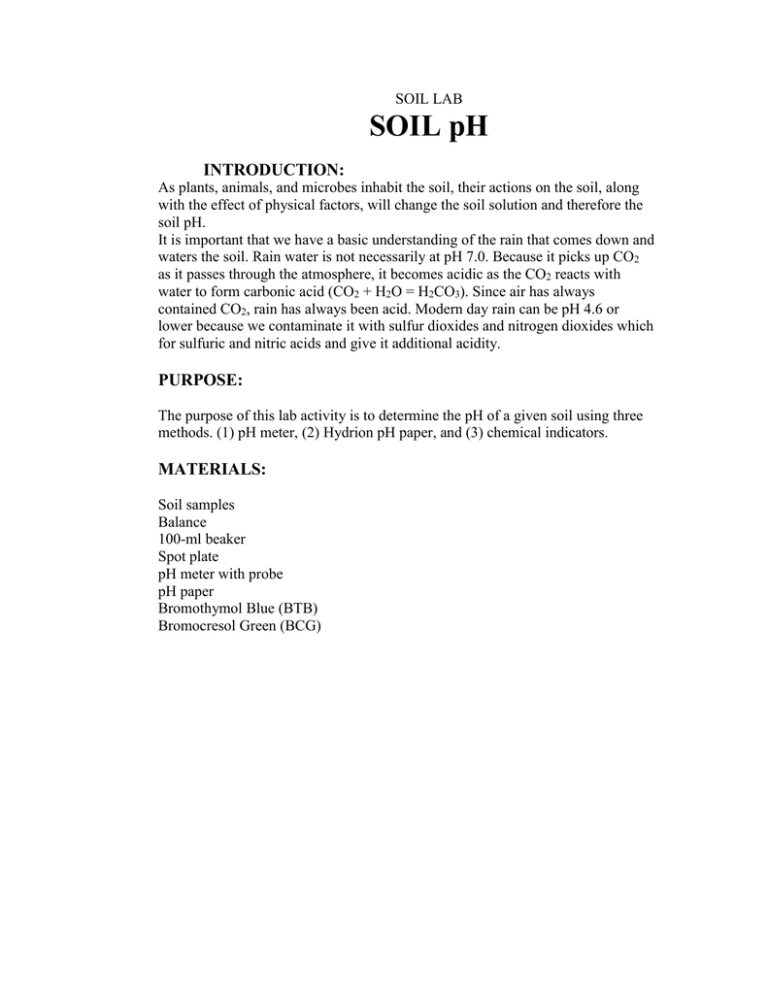Soil pH Lab
advertisement

SOIL LAB SOIL pH INTRODUCTION: As plants, animals, and microbes inhabit the soil, their actions on the soil, along with the effect of physical factors, will change the soil solution and therefore the soil pH. It is important that we have a basic understanding of the rain that comes down and waters the soil. Rain water is not necessarily at pH 7.0. Because it picks up CO2 as it passes through the atmosphere, it becomes acidic as the CO2 reacts with water to form carbonic acid (CO2 + H2O = H2CO3). Since air has always contained CO2, rain has always been acid. Modern day rain can be pH 4.6 or lower because we contaminate it with sulfur dioxides and nitrogen dioxides which for sulfuric and nitric acids and give it additional acidity. PURPOSE: The purpose of this lab activity is to determine the pH of a given soil using three methods. (1) pH meter, (2) Hydrion pH paper, and (3) chemical indicators. MATERIALS: Soil samples Balance 100-ml beaker Spot plate pH meter with probe pH paper Bromothymol Blue (BTB) Bromocresol Green (BCG) PROCEDURE: pH paper and pH meter 1. Record on the data table the soil sample number. 2. Weigh out 20g of dry soil in a 100-ml beaker. 3. Add 20 ml of distilled water and stir intermittently for 20 minutes allowing for the paste to reach equilibrium. 4. Measure the liquid phase of the soil-water mixture using the pH paper and pH meter. Record your results on the data table. Measuring Soil pH With Indicator Chemicals 5. Place a small sample of your soil in a spot plate hole (about 1 / 3 full). 6. Add enough Bromothymol Blue (BTB) to saturate the soil plus a few drops extra. Precautions: Both indicators (BTB, BCG) must be at the Mid-color of their range when observed in the dropper. If any one is to the right of Mid-color, add drops of diluted acid (very dilute HCl or even a little vinegar would do) and shake to adjust it. If any one is yellow, add drops of diluted base (very dilute NaOH or even a little baking soda would do) and shake until it turns green. Tap water and soaps are usually basic so rinse spot plates and glassware thoroughly with distilled water. Your skin is very acid so don't get fingers into either the indicator solutions or any water solutions. Tilt the spot plate back and forth to move the indicator solution through the soil, but gently so it doesn't get to muddy. Do this for at least a minute. 7. Roll the solution to one side and estimate its color to indicate the pH level from the following: Record your answer on the data table. For Bromothymol Blue (BTB) Blue = 7.4 or more Blue-green = 7.0 Green = 6.6 Yellow-green = 6.2 Yellow = 5.8 or less if the color of the BTB is yellow (ie. for more acid soils), then take another sample and try Bromocresol green (BCG). BCG makes the same color changes as does BTB but it does so between pH 3.8 - 5.4. Use the same procedure as above and the colors will indicate the following pH levels: For Bromcresol Green (BCG) Blue = 5.4 or more Blue-green = 5.0 Green = 4.6 Yellow-green = 4.2 Yellow = 3.8 or less DATA TABLE: Soil sample number. ________ Soil pH as measured by the pH paper. ________ Soil pH as measured by the pH meter. ________ Soil pH as measured by Bromothymol Blue (BTB). ________ Soil pH as measured by Bromocresol Green (BCG) IF NECESSARY. ________


